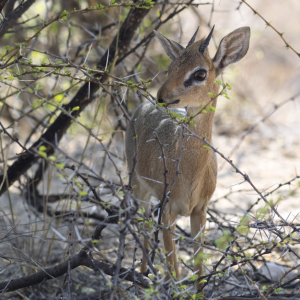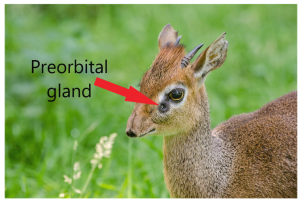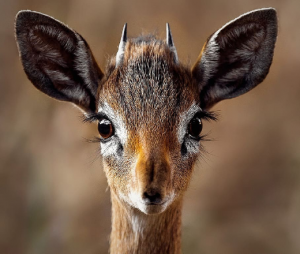By Zoe Terwilliger
 Many of us have seen the loveable dik-dik in memes and movies like Madagascar, however they are much more than just an adorable character. While these tiny creatures are similar to the deer we have here in the United States, dik-diks are a type of dwarf antelope. Dwarf antelope are a subfamily of antelopes which includes any antelope weighing less than 30 kg, or 66 lbs. The average adult dik-dik is fewer than 13 pounds – that’s less than 2 gallons of milk- and are only 1.5 to 2 feet tall. This means dik-diks are only about twice the size of a Chihuahua! Dik-diks are mostly brown with grey-brown backs, which allows for easy camouflage in their East African habitats. They have small tufts of hair on the tops of their heads resembling tiny mohawks. The males can be seen with small (3 in.) horns that angle backwards on either side of their hair tufts. While the small stature of these animals makes them especially cute, it does make them very vulnerable to predation. Predators of the dik-dik include baboons, lions, hyenas, leopards, eagles, and pythons. Dik-diks mostly eat fruits, however the unique snout of the dik-dik allows them to eat the leaves on acacia trees without being poked by the long thorns.
Many of us have seen the loveable dik-dik in memes and movies like Madagascar, however they are much more than just an adorable character. While these tiny creatures are similar to the deer we have here in the United States, dik-diks are a type of dwarf antelope. Dwarf antelope are a subfamily of antelopes which includes any antelope weighing less than 30 kg, or 66 lbs. The average adult dik-dik is fewer than 13 pounds – that’s less than 2 gallons of milk- and are only 1.5 to 2 feet tall. This means dik-diks are only about twice the size of a Chihuahua! Dik-diks are mostly brown with grey-brown backs, which allows for easy camouflage in their East African habitats. They have small tufts of hair on the tops of their heads resembling tiny mohawks. The males can be seen with small (3 in.) horns that angle backwards on either side of their hair tufts. While the small stature of these animals makes them especially cute, it does make them very vulnerable to predation. Predators of the dik-dik include baboons, lions, hyenas, leopards, eagles, and pythons. Dik-diks mostly eat fruits, however the unique snout of the dik-dik allows them to eat the leaves on acacia trees without being poked by the long thorns.
Dik-diks also have a feature common in hooved animals (ungulates) called the preorbital gland. This gland is similar to a sweat gland in humans and is located just in front of the eyes of hooved animals. This gland produces a dark fluid that dik-diks will often rub onto branches and leaves. The secretions from this gland have several functions like marking territory and asserting dominance.
The secretions of the preorbital gland are importa nt in the unique mating habits of dik-diks. Dik-diks are monogamous, meaning they only have one mating partner, a behavior that is rare in the animal kingdom. The preorbital glands secretions help male dik-dik’s establish their territory and protect their mates from other males. Ecologists believe that the monogamous preferences of dik-diks may be beneficial because their size makes them such an easy target for predators. One group of scientists noted that dik-dik partners spend about 64% of their time together. Males will often protect their female partners by waiting for the female to urinate and defecate and then cover the droppings with their own. This action masks the smell of the female and is another method of territory marking. While secretions of the preorbital gland also aid in warning others, if a male encounters other males in different territories they will engage in a rushing ritual. This ritual involves the animals charging at one another, stopping short of colliding, nodding, and walking away. They will repeat this display while lengthening the distance until one surrenders.
nt in the unique mating habits of dik-diks. Dik-diks are monogamous, meaning they only have one mating partner, a behavior that is rare in the animal kingdom. The preorbital glands secretions help male dik-dik’s establish their territory and protect their mates from other males. Ecologists believe that the monogamous preferences of dik-diks may be beneficial because their size makes them such an easy target for predators. One group of scientists noted that dik-dik partners spend about 64% of their time together. Males will often protect their female partners by waiting for the female to urinate and defecate and then cover the droppings with their own. This action masks the smell of the female and is another method of territory marking. While secretions of the preorbital gland also aid in warning others, if a male encounters other males in different territories they will engage in a rushing ritual. This ritual involves the animals charging at one another, stopping short of colliding, nodding, and walking away. They will repeat this display while lengthening the distance until one surrenders.
Another cool feature of the dik-dik actually comes from their name. Dik-diks get their name from the unique call the females make when they are scared that sounds like “dik-dik” or “zik-zik”. This call is described as a high-pitched wheezing or whistling sound that can be heard by surrounding creatures. In the wild, this noise alerts many hunted animals to the presence of danger and gives them time to escape.
this noise alerts many hunted animals to the presence of danger and gives them time to escape.
Dik-diks are more than just a hilarious cartoon character or a cute miniature deer. They are in a limited group of animals that have monogamous mating habits. They have snouts that are able to strip the thorny acacia tree of its leaves. Dik-diks are important to the food chains of many African animals and they act as an alarm system to signal danger. While this African dwarf antelope is not part of the numerous species that are threatened or endangered on the African continent due to poaching, they are a key factor in protecting many other species.
Edited by Anna Wheless and Emma Goldberg
